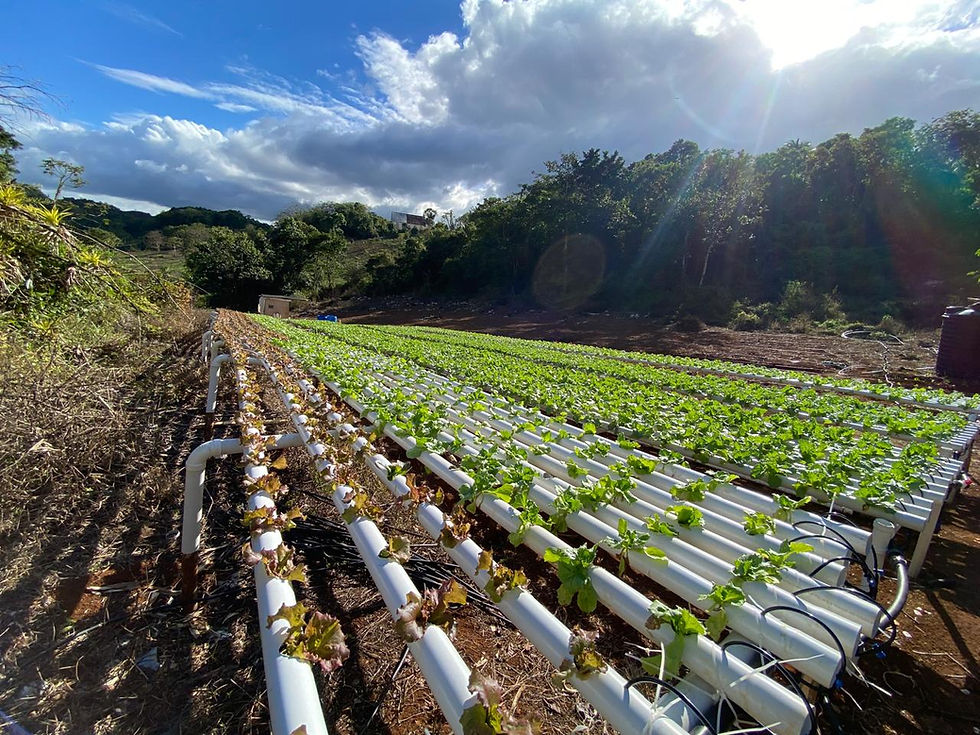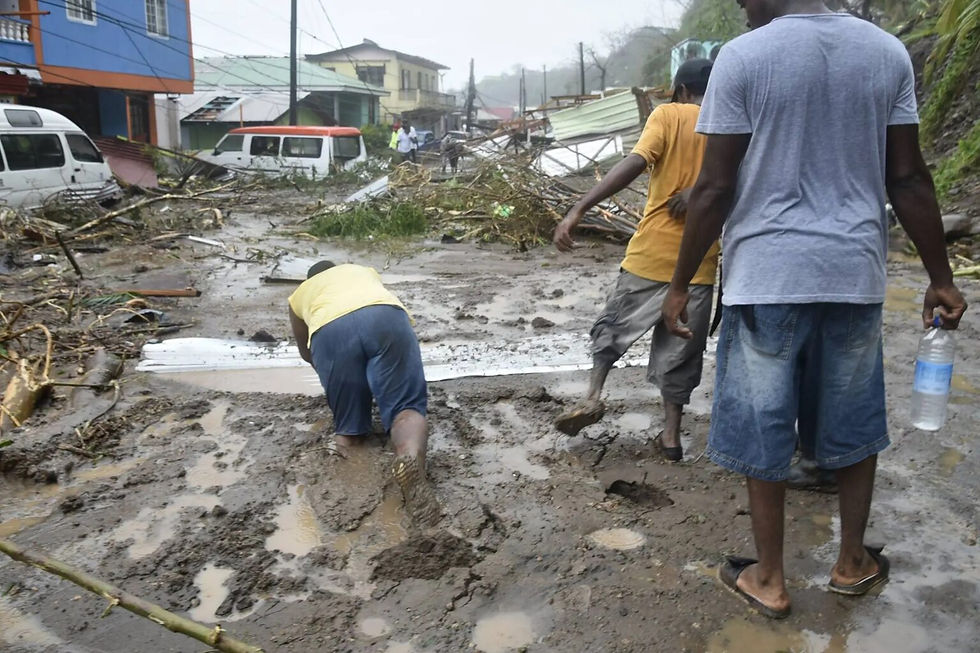It’s Flipping Time for Greener Caribbean MBAs | Re-designing Curriculum for a Climate-resilient, Islanded Region
- aquest

- Jul 21
- 6 min read

Caribbean societies are facing fierce climate headwinds. Climate change, fluctuating energy prices, deep inequalities, and the damaging heritage of unsustainable growth all threaten our way of life. While much attention is given to our low-lying coasts vulnerable to sea level rise and hurricanes, it is critical to remember that many Caribbean islands are mountainous, with steep terrains prone to land slippage and catastrophic landslides during rainy or hurricane seasons.
The Multifaceted Climate Challenge: Not just Rising Seas
Coastal threats—erosion, seawater intrusion, coral bleaching—have been widely documented. Yet, the geography of the Caribbean is diverse. Islands like Jamaica, Dominica, St. Lucia, Grenada, and others are characterised by rugged, mountainous interiors. Here, climate-induced hazards take on additional forms:
Landslides and land slippage: Heavy rainfall and hurricanes frequently trigger devastating slope failures in the uplands, putting both lives and property at risk.
Flash floods and road disruptions: Steep river valleys become conduits for destructive flooding, undermining critical infrastructure and commerce.
Water security challenges: Mountain catchments are lifelines for water supply but also vulnerable to deforestation and soil loss.
In both coastal and highland settings, these destabilising forces threaten food security, GDP, investor confidence, and the very viability of Caribbean societies.

A Syllabus Stuck in the Past
At a time when the region faces ecological threats unique to both its shores and hillside communities, most Caribbean business schools persist with curricula disconnected from these existential risks:
International peers have moved ahead: Harvard, INSEAD, Stanford, Oxford Saïd—all embed sustainability, ESG, and climate risk deep into their core training.
Caribbean students deserve the same: Business graduates from Kingston, Santo Domingo, Paramaribo, Bridgetown, Roseau, Castries, Georgetown, and beyond should be fluent in:
Renewable energy economics and project finance
Climate risk, disaster preparedness (including upland threats like landslides)
Sustainability reporting and ESG compliance
Green entrepreneurship, circular business models, and inclusive innovation
Yet too often, these topics are minor electives or side-dish workshops—when they should be pillars of the curriculum of courses.

The Cost of Delay
This gap between global best practice and Caribbean reality comes at a steep price:
Every hurricane season, landslides and flooding cause loss of life and business. The 2017 passage of Hurricane Maria over Puerto Rico, Dominica and other mountainous islands showed the deadly consequences of ignoring terrain-specific risks.
Oil import dependency remains high (eight–18 per cent of GDP in many countries), which erodes fiscal space to invest in resilience.
Unprepared graduates undermine economic progress: Without climate competence, new business leaders cannot attract green investment or drive adaptive local enterprise.
The Power and Responsibility of Business Schools
Business schools are uniquely positioned to turn the tide, if they overhaul both vision and syllabus. This transformation is not just about academic trend-following:
It is about survival, especially for highland and coastal communities alike.
It is about seizing new green market opportunities—from disaster risk financing to climate-adaptive agriculture and resilient infrastructure.
It is about justice, for young leaders from flood-prone valleys or landslide-threatened hillsides, who need skills and knowledge to protect their communities.
Reimagining the Curriculum: What Must Change
1. Make resilience education core, not peripheral
Integrate climate risk assessment for flood, hurricane, and landslide exposure as standard business analysis.
Make renewable energy, adaptation finance, disaster risk reduction, and ecosystem services part of graduation requirements.
Address terrain-sensitive threats and strategies, such as land-use planning for mountainous villages and businesses.

Credit: OurToday (Photo: Lieutenant Commander Kevin Doremus, NOAA Corps for National Oceanic and Atmospheric Administration | X.com @NOAA_HurrHunter) An incredible shot of Hurricane Beryl’s calm eye as pictured on Wednesday morning, July 2, 2024, when the cyclone was still at category five intensity over the central Caribbean Sea.
2. Promote interdisciplinary and experiential learning
Develop courses taught jointly by business, engineering, climate science, agronomy, and public policy faculty staff.
Facilitate hands-on projects—consulting engagements with businesses vulnerable to slope failure, water scarcity, or hurricane disruption.
Organise fieldwork in both mountainous and low-lying communities as real-life cases.
3. Create micro-credential pathways
Design professional short courses and certifications in climate finance, disaster risk management, circular economies, ESG, and community-based innovation.
Encourage partnerships with global and regional organisations already pioneering climate-adaptive business education.
4. Localise case studies and knowledge
Commission and fund applied research on issues such as:
Market strategies for mountainous agriculture
Disaster insurance for businesses on hillsides
The economic case for reforestation and slope stabilisation
Produce region-specific teaching materials that address the Caribbean’s physical diversity, not just generic SIDS (small island developing states) cases.
5. Advance regional collaboration
Foster regional alliances to share resources, best practices, and faculty expertise.
Build joint programs and exchanges with institutions leading in climate-smart business.

Denise A. Forrest, DBA. (Photo: Contributed)
Practical Action: Advancing the Green Curriculum
Immediate steps Caribbean business schools, regulators, and employers can take:
Convene a region-wide roundtable (business faculties, private sector, government, students) to develop standards and benchmarks for a climate-and-terrain-responsive curriculum.
Mandate climate and resilience literacy as part of degree accreditation.
Establish innovation hubs and business clubs focused on climate-adaptive and green entrepreneurship—especially in mountainous and highland regions.
Medium-term goals:
Undertake a comprehensive audit of current curricula—identify gaps, especially in mountain-specific climate hazards and green enterprise.
Secure funding from donors, banks, and the private sector for curriculum reform, faculty training, and micro-credential programs.
Recognise and reward innovation in faculty teaching and student leadership in mountain and climate risk management.
The Business Case: Why a Green, Mountain-savvy Business Education Matters For MBAs
Employers are demanding ESG and climate literacy, including disaster preparedness across diverse landscapes.
Green investors need local expertise to unlock capital flows. The Caribbean’s mountainous regions are prime candidates for nature-based solutions that can attract impact investment.
Prepared graduates drive both resilience and opportunity in tourism, green renewable energy, sustainable agriculture, and infrastructure.
Leading the way raises the profile of Caribbean business schools and attracts top students and research funding.
Vision: Caribbean as Global Model, Not Passive Consumer
The Caribbean—mountainous as well as coastal—should not merely import foreign templates but instead export “tropicalised” business models and resilience strategies. From renewable energy microgrids in hilly districts to circular rural enterprises, we have the creativity and conditions to set new global standards.

Conclusion: Planting the Seeds of a Just, Resilient and Green Century
Uplands and lowlands together, the Caribbean’s future depends on business schools embracing a new mission: to become chief architects and advocates of sustainable, terrain-smart progress. The curriculum must reflect not just generic vulnerability, but the unique risks and strengths of our mountainous as well as coastal home.
Let us begin this transformation—so our graduates can lead, thrive, and protect all corners of our diverse islands, from the steepest hillside to the swaying shore.
COMMENTS
This reminds me of a text I became fond of when I was in the Church:
"For I bear them witness that they have a zeal..., but not according to knowledge." – Romans 10:2
The zeal of these climate zealots is sincere. Earth's ever changing climate does pose considerable threats to our lives.
But when people start spouting off about ESG, climate inequity, carbon footprints and the like, it exposes the fact that they have been brainwashed into a state of climate hysteria. Not once have these people ever questioned the narrative they have been fed.
How accurate are the climate models? Why have their predictions been wrong so many times? How effective is carbon dioxide as a greenhouse gas anyway? How does it compare to water vapour, which we cannot control? Is net-zero even possible? Don't carbon credits give wealthy industries permission to pollute? What about China’s and India’s pollution? Are there more powerful influences on Earth's climate than our carbon emissions, like perhaps... Earth's ever-changing proximity to the sun?
"Scientists said it, so it must be science, and I believe the science" is the foundation of their zeal.
Very similar to "Pastor said it, Pastor speaks for God, so I believe the Pastor".
Dennis A. Minott, PhD Insight4Sight 19 hours ago edited
Insight4Sight, Would it not be often far better you reflect on Proverbs 17:28:
“Even a fool, when he holdeth his peace, is counted wise...”
Must you, Insight4Sight of SMR folly, always confirm our worst suspicions?
Sometimes silence preserves dignity—yours included. Not every impulse of a billioneerer deserves a microphone, especially when it exposes more ignorance than insight.
Pause. Breathe; Ask ChatGPT.
Then—maybe—speak.
Dennis A. Minott, PhD, of ENERPLANVerde Siempre Group, is a physicist, green resources strategist, and founder of A-QuEST (Association of Quietly Excellent Scholars and Thinkers). He has long advocated for climate-responsiveness, education, green energy, and genuine sustainability leadership in the Caribbean.
Denise A. Forrest, DBA, of ENERPLANVerde Siempre Group, is a biochemist, bioprocess engineer, and Managing Director of Forrest and Partners Ltd, Environmental Consultants and Project Managers.
by Dennis A. Minott, PhD. MISES and Dr Denise A. Forrest, DBA.
July 18, 2025
%202021_edited_edited.jpg)





Comments